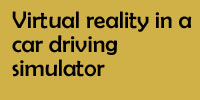There are hugh differences in quality of driving schools. It is difficult to pinpoint exactly which factors determine whether a driving school is good or bad. There has been a lot research into factors that determine the quality of driver training, and the most consistent finding is that the amount of practice in relevant driving tasks is a very important factor. Lack of driving experience is probably the most important reason why young drivers fail for their driving exams or are overrepresented in the accident statistics. This would suggest that driving schools with an excellent track record generate more driving experience in their students, although this has not been investigated properly. This finding suggests that it is generally not a very good idea to apply for courses that promise passing the exam within only one week (crash courses). It also suggests that a learner permit where young drivers are supervised by an experienced driver and have to practice a lot while they are only allowed to drive in favourable circumstances (for example only during daylight) is probably a good idea. It has never been proved that supervision by professional instructors results in better drivers or higher pass rates at exams, compared to supervision by parents. All in all, extensive practive before the driver exam is taken appears to be the most important factor.
But it is clear that quality of the driving school is an important factor that affects the choice of a driving school by a learner driver. In most countries it is difficult for a customer to find out which driving school is the best. In the Netherlands, around 7750 driving schools were registered in 2012. All driving instructors have to be licenced and all have followed extensive training to become a registered instructor. In order to apply for your driving test, on average 40 lessons (one hour per lesson) are required in a learner car on public roads. The instructor determines when the learner driver drives good enough to have a good chance to pass for the exam. Still, year after year the average pass ratio for the driver test (first time) is 50%.
In the Netherlands the pass ratios of driving schools are publicly available via the website of the examination institute (CBR). These numbers are available to the public and are used by learner drivers to choose a driving school. A number of driving schools have consistent high scores while other driving school consistently perform poorly on pass ratio. What is a good driving school is a matter of definition ofcourse, but lets define a good driving school as a driving school where more than 75% of all students pass the first time they do the driving test. Over a large sample of driving schools, around 12,5% of all driving schools can be qualified as ‘good’, according to this definition. If we define a poor driving school as one where only 25% of all students pass for their exam the first time, then around 17,5% of all driving schools can be considered ‘poor’. 70% of all driving schools are then ‘average’.
The ‘good’ driving schools generally attract a lot of learner drivers. They do well economically, while the ‘poor’ driving schools struggle to survive, in general, in this very competitive market. Ofcourse there will always be a normal distribution of pass ratios where there will be relatively good and relative poor driving schools, but a pass percentage lower than 25% is low according to Dutch standards, where a pass ratio of 50% is considered ‘normal’. These driving schools can benefit strongly by using a car simulator to increase the level of practice and task automation in their students. This increases the quality of driver training for these driving schools because the simulator curriculum promotes task automation and extensive practive in relevant driving tasks. It is expected that this will increase the pass ratio and thus attract more customers.


